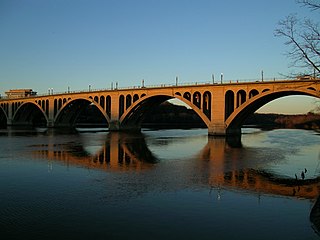
The Francis Scott Key Bridge, more commonly known as the Key Bridge, is a six-lane reinforced concrete arch bridge conveying U.S. Route 29 (US 29) traffic across the Potomac River between the Rosslyn neighborhood of Arlington County, Virginia, and the Georgetown neighborhood of Washington, D.C. Completed in 1923, it is Washington's oldest surviving road bridge across the Potomac River.

The Humpback Covered Bridge located in the U.S. state of Virginia, is one of the few remaining covered bridges in the United States that was built higher in the middle than on either end; hence the name of "humpback". The bridge was built in 1857 and is also the oldest remaining covered bridge in the state of Virginia. Its WGCB number is 46-03-01. The bridge spans a tributary of the Jackson River known as Dunlap Creek, for a distance of 109 feet (33 m). The humpback feature is 4 feet (1.2 m) higher in the center than at either end. The bridge is located near the city of Covington, Virginia.

The Lamar Boulevard Bridge is a historic arch bridge carrying Texas State Highway Loop 343 over Lady Bird Lake in downtown Austin, Texas, United States. The bridge features six open-spandrel concrete arches spanning 659 feet (201 m) and carries tens of thousands of vehicles daily across the lake. Completed in 1942, the Lamar Boulevard Bridge was the second permanent bridge to cross the Colorado River, and one of the last Art Deco-style open-spandrel concrete arch bridges built in Texas. The bridge was named an Austin Landmark in 1993 and added to the National Register of Historic Places in 1994.

The Reynolds Bridge in Thomaston, Connecticut is an open-spandrel concrete arch bridge carrying Waterbury Road over the Naugatuck River. Built in 1928, it is one of a small number of surviving open-spandrel bridges in the state. It was listed on the National Register of Historic Places in 2004.

The County Road C117–Pike River Bridge is a steel stringer bridge located on County Road C117 over the Pike River just south of Chassell, Michigan. The bridge was placed on the National Register of Historic Places in 1999.
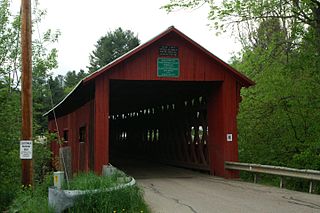
The Northfield Falls Covered Bridge, also called the Station Covered Bridge, is a wooden covered bridge that carries Cox Brook Road across the Dog River in Northfield, Vermont. Built in 1872, this Town lattice truss bridge is one of five surviving covered bridges in the town, and one of two that are visible from each other. It was listed on the National Register of Historic Places in 1974.

The Lower Cox Brook Covered Bridge is a wooden covered bridge that crosses Cox Brook in Northfield, Vermont on Cox Brook Road. Built in 1872, it is one of five surviving 19th-century covered bridges in the town, in the only place in Vermont where two historic bridges are visible from each other. It was listed on the National Register of Historic Places in 1974.

The County Road 557–West Branch Escanaba River Bridge is a bridge located on County Road 557 as it passes over the West Branch of the Escanaba River in Wells Township in Marquette County, Michigan. It was listed on the National Register of Historic Places in 1999.
The Forest Route 157–Tamarack River Bridge, also known as the San Souci Bridge, was a bridge located on Federal Forest Highway 157 over the Tamarack River in Stambaugh Township, Michigan. It was listed on the National Register of Historic Places in 1999, and demolished c. 2008.
The US 2–Iron River Bridge, also known as the Genesee Street Bridge, is a bridge located on Genesee Street over the Iron River in Iron River, Michigan. It was listed on the National Register of Historic Places in 1999.
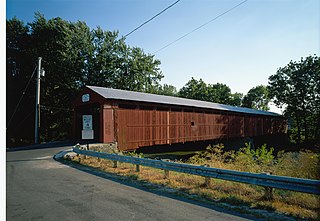
The Eldean Covered Bridge is a historic covered bridge spanning the Great Miami River in Miami County, Ohio north of Troy. Built in 1860, it is one of the nation's finest surviving examples of a Long truss, patented in 1830 by engineer Stephen H. Long. At 224 feet (68 m) in length for its two spans, it is the longest surviving example of its type. It was listed on the National Register of Historic Places in 1975, and was designated a National Historic Landmark in 2016.

Meems Bottom Covered Bridge is a covered bridge in Shenandoah County, Virginia, United States. The bridge, at 204 feet (62 m), is the longest covered bridge in Virginia and one of the last that supports regular traffic. Near the town of Mount Jackson, the Meems Bottom Covered Bridge features a 200-foot single-span wooden Burr arch structure. Built in 1892 by Franklin Hiser Wissler, the wooden bridge over the North Fork of the Shenandoah River provided access to his apple orchards at Strathmore Farms. The bridge was listed on the National Register of Historic Places on June 10, 1975.
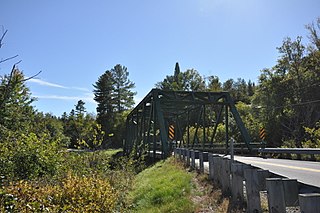
The Bloomfield-Nulhegan River Route 102 Bridge is a historic bridge in Bloomfield, Vermont. It carries Vermont Route 102 over the Nulhegan River, near its mouth at the Connecticut River just south of Bloomfield Village. Built in 1937, it is a well-preserved example of a Pratt through truss, exhibiting then state-of-the-art engineering. It was listed on the National Register of Historic Places in 1991.

The Bridgewater Corners Bridge carries Vermont Route 100A across the Ottauquechee River in the Bridgewater Corners village of Bridgewater, Vermont. It was built in 1928 by the American Bridge Company, following devastating flooding. It is a single-span Pratt through truss structure, and was listed on the National Register of Historic Places in 1992.

The Gould's Mill Bridge is a historic Baltimore through truss bridge, carrying Paddock Street across the Black River in Springfield, Vermont. The bridge was built by the Boston Bridge Works Company in 1929 after major flooding in 1927, and is one of the state's few examples of a Baltimore truss. It was listed on the National Register of Historic Places in 2006.

The Quechee Gorge Bridge is a historic bridge, carrying U.S. Route 4 (US 4) across Quechee Gorge, near the Quechee village of Hartford, Vermont. Built in 1911, it is Vermont's oldest surviving steel arch bridge. It was listed on the National Register of Historic Places in 1990.

The Middlebury Gorge Concrete Arch Bridge is a historic concrete arch bridge, carrying Vermont Route 125 over the Middlebury River in eastern Middlebury, Vermont. The bridge was built in 1924, and is a well-preserved example of an early concrete bridge. It was listed on the National Register of Historic Places in 1991.
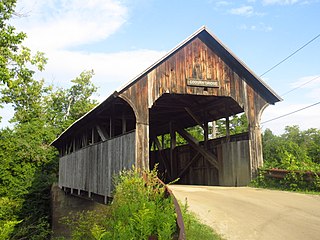
The Coburn Covered Bridge is a historic covered bridge, carrying Coburn Road over the Winooski River in eastern East Montpelier, Vermont. Built in 1851, it is the town's only surviving 19th-century covered bridge. It was listed on the National Register of Historic Places in 1974.

Bridge 9 is a historic Parker through truss bridge, carrying Shawville Road across the Missisquoi River in Sheldon, Vermont. Built in 1928 after Vermont's devastating 1927 floods, it is one of the few surviving Parker truss bridges on the Missisquoi. It was listed on the National Register of Historic Places in 2007.

Bridge 12 is a historic Parker through truss bridge, carrying Boston Post Road across the Missisquoi River in Enosburg, Vermont. Built in 1929 in the wake of Vermont's devastating 1927 floods, it is one a shrinking number of surviving truss bridges on the river. It was listed on the National Register of Historic Places in 2007.






















